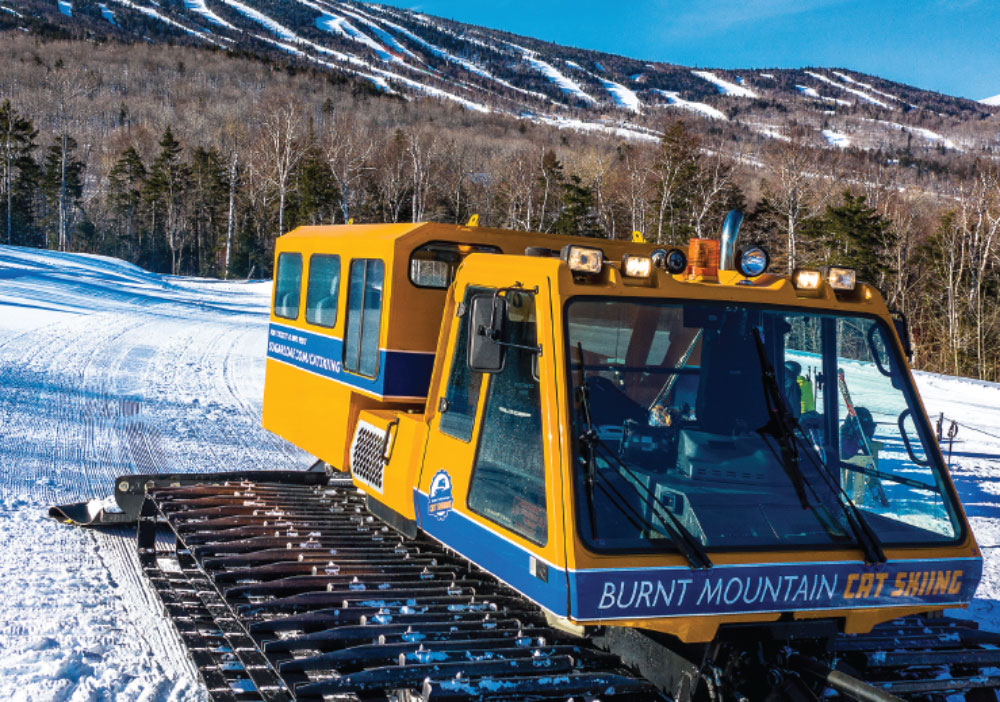There’s one kind of pleasure in gliding down a well-groomed, familiar run with the sun glinting off the tracks of other skiers. It’s quite a different experience to forge through fresh powder, navigating evergreen glades and exploring an exhilarating natural landscape.
Even if they love the ambience of a favorite resort, most experienced skiers crave the opportunity to push outside the usual boundaries from time to time. Few have the opportunity to try heli-skiing, but, increasingly, cat-skiing is becoming the adventure of choice for accomplished skiers who seek an extra thrill.
As its name suggests, cat-skiing, which was pioneered in 1975 by Allan and Brenda Drury of Selkirk Snowcat Skiing in Meadow Creek, B.C., allows skiers to travel to remote or otherwise inaccessible terrain using modified versions of the same machines used for grooming. Today there are about two dozen cat-skiing operations in Canada (mainly in B.C.), several in the U.S. and a few in other countries, and the numbers are growing.
Some cat-skiing operations are essentially an alternative to heli-skiing; these transport the participants to a wilderness location for several days. These trips require a dedicated staff of guides and drivers, and an extra level of safety instruction for staff and participants who may be exposed to risk from bad weather or avalanche hazards. Other programs function as an add-on to lift operations at an established resort and as such are bound by the same level of staff safety training as required by normal in-bound resort skiing.
The snowcats are customized for passenger transport, with passenger cabins that can accommodate about a dozen skiers. A heated vehicle with padded seats makes the scenic trip to the summit part of the attraction. The best news for operators who may be considering adding a snowcat option to their existing trails is that the vehicles don’t have to be new; it’s common for operators to repurpose an older machine that has previously served time grooming the hill.
Panorama Mountain Resort in Panorama, B.C., is a destination resort with unique offerings including a full destination helicopter skiing experience from the heart of the resort. When Panorama decided to add cat-skiing to the list, they chose a snowcat that had been retired from day-to-day front-line grooming and had it remodelled by Metal Form Industries, a company based in Innisfail, Alta., that specializes in this type of job.
“It had about 15,000 hours on it. It had been well maintained for its entire life, so we felt it was a cat worth repurposing,” said Panorama’s president and CEO Steve Paccagnan. “We worked with [Metal Form Industries] to customize the box; we shipped it to Calgary and had them put it through their paint shop so the cat and the cabin match.”
Now rechristened “The Monster,” the cat is emblazoned with the company logo and a caricature of a Yeti-like snow beast. The runs and trails in the cat-skiing area are also playfully named in keeping with the monster theme.
“The cat ride is a great experience,” Paccagnan said. “It’s in excellent condition – it’s really quite beautiful. It has a nice, plush interior. It holds 13 passengers and it’s got a full-blown wonderful stereo system; we play some good classic rock in there.”
Skiers use three quad lifts to reach the summit, where they board the snowcat for a 15-minute ride along the ridge line with beautiful views of the Rocky Mountains to the east and the Purcell range to the west. When they arrive at the resort’s Taynton Bowl, they have access to 2,300 feet of vertical skiing on 750 acres.
“There’s open-bowl skiing and gladed skiing, and some runs cut as well,” Paccagnan said. “It’s former helicopter skiing terrain, and you would ski the bowl to the bottom of the mountain and then take the lifts back up again.” One trip takes about 40 minutes and Paccagnan says an adventurous skier might make four runs in a day, perhaps combined with some of the lift runs. This makes the resort’s $49 four-pack a popular option. Panorama also sells a cat-skiing season pass for $199 and single rides for $15. All runs are first come, first served.
Panorama’s snowcat is never used for grooming, but it is repurposed in the evening for cat-assisted dining excursions to the resort’s Elkhorn Cabin, a picturesque and historic hand-hewn wooden cabin where guests dine on Alpine-style raclette (a traditional melted cheese dish) while feasting on the view over Mount Nelson. At $120 per person (maximum of 13 people), the package is “super-popular in the wintertime,” Paccagnan said.
To date, most of North America’s cat-skiing operators have been located near the Pacific coast, but there are a few in the east as well. One of these is Sugarloaf, currently the only resort offering cat-skiing in the state of Maine. Sugarloaf’s Burnt Mountain has recently been developed for cat-skiing. Guests board snowcats to climb more than 1.5 miles and 1,400 vertical feet to the upper elevations. From the peak of Burnt Mountain, they have a 360-degree range of access to over 100 acres, including the resort’s Androscoggin, Little Androscoggin and Kennebec glades.
“The fact that we’re able to do it here in the east really excites people,” said Tom Butler, Sugarloaf’s director of skier services. “We have great vertical, excellent snowfall and great terrain; you could ski off the top of the mountain just like you could out west.”
Cat-skiing ticket holders ride the resort’s Whiffletree lift to reach the departure point where they can enjoy hot chocolate and a firepit at a shelter building at the Log Yard. The snowcat brings skiers to the top and meets them at the bottom of each run for a return to the departure point. A $45 ticket is good for two consecutive runs, which take about 90 minutes in total. Guests tend to book ahead online, although they can also take their chances on finding an open spot when they arrive at the resort.
Sugarloaf has three dedicated, repurposed grooming vehicles that can carry ten passengers each. “We call them a ‘housecat,’ because you have your little house on the back of it,” Butler said. “They don’t do any grooming; they do have a plow on the front, and on the back there’s a big net to smooth out the snow after it goes through.”
Both Panorama and Sugarloaf permit skiers to participate at their own discretion. “They should be a strong expert skier and the terrain is marked Black Diamond and Double Diamond, so the level of skiing ability needs to match the terrain,” said Paccagnan.
“We do advertise it as advanced skiing because even though the pitch isn’t overly steep, skiing in untracked snow is challenging,” Butler said. “You’re skiing the conditions of the day; it could be really fluffy powder or crusty snow.”
At both resorts, cat-skiing opens up new possibilities for returning customers and may also attract a new clientele. “When we’re running it, it’s more often than not that we’re sold out, so we’re running full cats,” said Butler, who believes the option attracts some new skiers to the resort because it’s “a little different and a little unique in terms of in-resort skiing.”
The clientele for cat-skiing represents the full gamut of enthusiastic skiers of all age groups. Some of the business consists of group bookings, but in general, Paccagnan said, “It’s your typical ski day. It could be a small group of four, a couple or two friends.”
For wilderness cat-skiing excursions, the staffing demands are more significant, but, considering the potential return, an in-resort cat-skiing operation requires a relatively small increase in staff. At Panorama, “We have dedicated cat drivers and we’ve staffed accordingly for that,” said Paccagnan.
At Sugarloaf, “We hired somebody specifically to drive the cat,” said Butler. “It is patrolled by the ski patrol, so there are a couple of patrollers who can be dispatched from the top of the hill; we didn’t hire any added staff for that. There’s one person down at the warming hut – he’s our meeter-and-greeter. He just came from the lift service, so we didn’t hire somebody for the role, but we probably needed to fill his vacancy.”
One further consideration is the environmental impact of opening up new terrain to skiers. At Panorama, the bowl area is part of the resort’s Controlled Recreation Area, and as such was already covered under provincial regulations.
On Burnt Mountain, “We work very closely with the Department of Inland Wildlife and Fisheries when we start cutting trails so we’re not going to be disrupting any wildlife,” Butler said. “It turned out that there were a couple of areas we wanted to start opening up where, even at 3,000 feet, there are some little ponds that have fish in them, so we left pretty good buffers around those.”
Cat-skiing is not an option for every resort, but it offers exciting possibilities for the right location.
“You’ve got to assess who is your client? Is it something that fits with who you are as a resort? You need to have the ability to get in and out, but you want to give them the experience of being out in the middle of the woods, so there’s a fine balance,” Butler said.
“You look at the cost of the asset; you want the cat to be in perfect working condition because down time is frustrating,” said Paccagnan. “Does this business model work, based on a differentiated value model? It has to be unique, differentiated and something that the customer would see value in and want to participate in.”
photo courtesy of Sugarloaf



![[image placeholder]](https://www.snowopsmag.com/wp-content/uploads/2023/09/placeholder@2x-890x664.png)